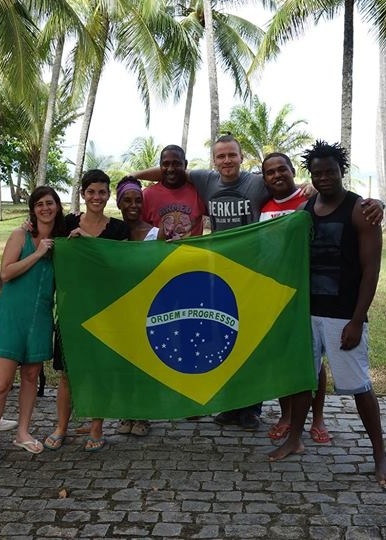OCTOBER / DECEMBER 2014 FELLOWS
Sacatar hosted five Fellows in the October-December residency session. Each engaged with the local culture in ways meaningful to their artistic practice, as you will see below:

October / December Fellows: Romy, Lina, Germaine, Antônio (Sacatar employee), Liutauras, Augusto (Sacatar Manager) and Mário © 2014, Liutauras Janusaitis’ personal collection
GERMAINE INGRAM, a Pew Fellow, dancer and choreographer from Philadelphia, Pennsylvania, came to Sacatar through a partnership between the Sacatar Foundation and Dance-UP. She undertook research in the areas of dance, theater and music in order to understand how the Afro-descendent communities of Brazil maintain or forget their cultural heritage dating back to the time of slavery. In Itaparica, she visited Candomblé terreiros (sites where African religions are still practiced) and witnessed ceremonies of various African traditions. In Salvador, she met several times with the local puppet theater troupe, A Roda, and its director Olga Gomez. She also did a workshop at the Dance Department of the Universidade Federal da Bahia and gave classes to actors who are preparing a production of Shakespeare’s Hamlet at the Teatro Vila Velha. She collaborated with the musician and Sacatar Fellow LIUTAURAS JANUSAITIS for two performances of music and dance presented to the public during the Open Studio, held at the end of their residencies.
The Lebanese writer LINA EL-MOUNZER came to Sacatar through a partnership with UNESCO-Aschberg. During her residency, she worked on a novel about the aftermath of the Lebanese civil war and how it has affected the art and lives of its people, tracing the psychological shrapnel of a single car bomb in 1984 through the lives of several survivors over twenty years. Lina also wrote the following poem, based on her impressions of Itaparica, for the musician LIUTAURAS JANUSAITIS, who set it to music.
In a place like this
Where the landscape is continuously made and unmade
Coming back to its many familiar shapes in cycles of push and pull
It is easy to imagine redrawing time.
To redraw time, what would that look like?
Instead of a line moored in a fixed past, extending toward an uncertain future
In a place like this you could draw a circle instead.
(It is a circle so vast, it might, from where you’re standing, look like a line
The way the horizon once seemed like the straight-edge end of the world
To the first sailors
Who feared they might plunge to their deaths
But pressed on anyway to find new shores
And came back bearing tales of a world without end.)
If time is a circle it doesn’t matter where you end and where you begin,
because there are infinite beginnings and infinite endings.
It is easier then to imagine the fading of your own capacity to witness
In favor of someone else’s.
It is easier to imagine the tides receding and coming back, the constellations wheeling and returning,
Without need of any witness.
It is easier to imagine sailing off the edge of the world,
Only to find yourself coming home, back to the place where you began.
If time is a circle, you are always setting out and always returning.
If time is a circle, every moment is every beginning and every end.
Where the landscape is continuously made and unmade
Coming back to its many familiar shapes in cycles of push and pull
It is easy to imagine redrawing time.
To redraw time, what would that look like?
Instead of a line moored in a fixed past, extending toward an uncertain future
In a place like this you could draw a circle instead.
(It is a circle so vast, it might, from where you’re standing, look like a line
The way the horizon once seemed like the straight-edge end of the world
To the first sailors
Who feared they might plunge to their deaths
But pressed on anyway to find new shores
And came back bearing tales of a world without end.)
If time is a circle it doesn’t matter where you end and where you begin,
because there are infinite beginnings and infinite endings.
It is easier then to imagine the fading of your own capacity to witness
In favor of someone else’s.
It is easier to imagine the tides receding and coming back, the constellations wheeling and returning,
Without need of any witness.
It is easier to imagine sailing off the edge of the world,
Only to find yourself coming home, back to the place where you began.
If time is a circle, you are always setting out and always returning.
If time is a circle, every moment is every beginning and every end.
LIUTAURAS JANUSAITIS, a musician and composer from Lithuania, came to Sacatar through a partnership with UNESCO-Aschberg. During his residency he met local musicians and worked in various musical styles, including jazz, electronic music and compositions for string orchestra. However, he primarily dedicated himself to the composition of a CD of music, entitled Infinity, inspired by the peace and tranquility he found at Sacatar. He collaborated with the other Fellows in residence on the creation of this CD.
LINA EL-MOUNZER contributed a poem and the photographers MÁRIO MACILAU and ROMY POCZTARUK contributed photos for the CD cover. Liutauras also collaborated with GERMAINE INGRAM with whom he did two performances during the Open Studio held at the end of their residencies.
MÁRIO MACILAU, a photographer from Mozambique, came to Sacatar through a partnership with UNESCO-Aschberg. Among other activities, he accompanied ROMY POCZTARUK in her explorations of the island in search of ruins to photograph.
ROMY POCZTARUK, a Brazilian photographer, continued work on a photographic series of architectural ruins, documenting places that have been forgotten. She photographed various historic locations on the island of Itaparica and across the bay in Salvador. She also visited several terreiros de Candomblé (sites where African religions are still practiced), witnessed rituals and interviewed priestesses who maintain these African traditions.




